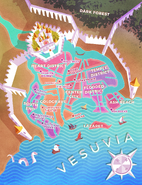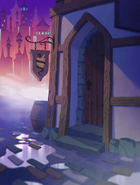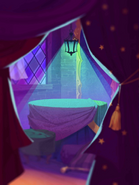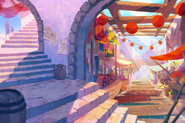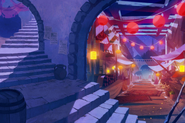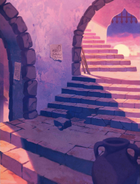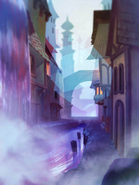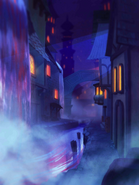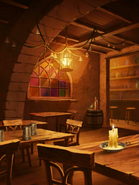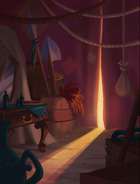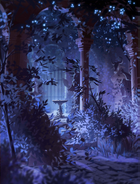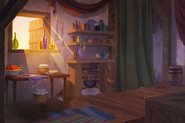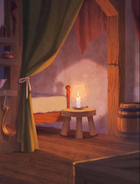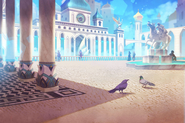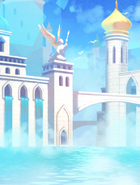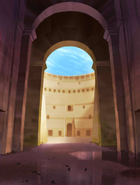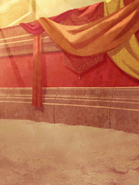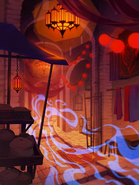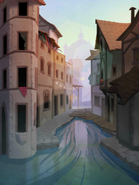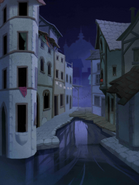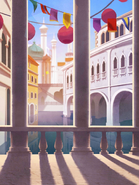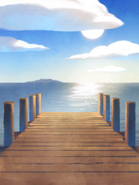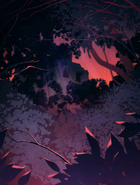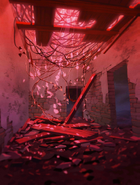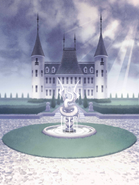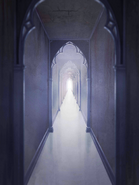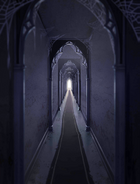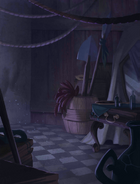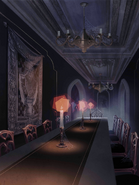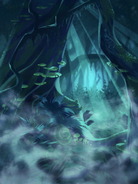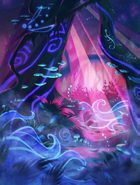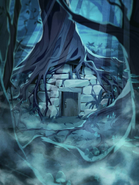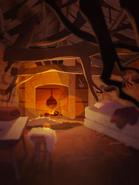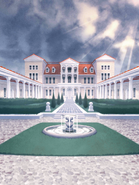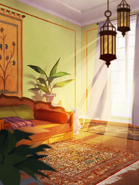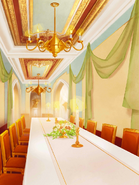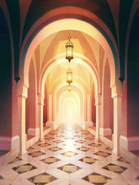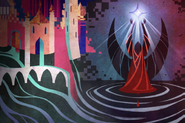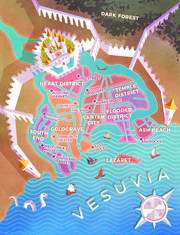
Map of Vesuvia
| “ | I, Count Prospero, first of my line, declare the founding of Vesuvia. The city eternal. My legacy. | „ |
| ~ The first Count of Vesuvia |
Vesuvia is the main setting for the Arcana Game. A city-state built into a cliff by a Mediterranean-like sea, Vesuvia is located in the southern hemisphere of the world. It is a center for trade, travel, and cultural exchange, and is known for its tangled, multi-layered network of canals and aqueducts. It is currently ruled by the widowed Countess Nadia after the death of her husband, Count Lucio, three years prior to the start of the game.
Districts[]
Heart District[]
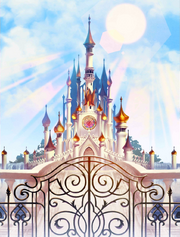
Vesuvian Palace
Vesuvia’s wealthy elite make their home here (or second home, in the case of landholding nobility). Gleaming white architecture is offset by the glittering array of jewels and finery available in the upscale Floating Market. During Lucio’s reign, Red Street was an even more popular shopping destination, offering the most luxurious and fashionable garments dyed in the Count’s signature Vesuvian Red . . . ever since the plague, however, Red Street has been almost entirely abandoned. Residents of the Heart District mourn the loss of their beloved late Count - and particularly mourn the magnificent festivities he so often hosted.
Center City[]
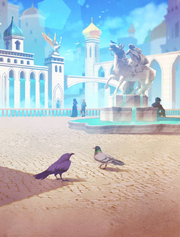
Town Square
The Apprentice’s neighborhood is not too quiet, not too loud. The streets by the Magic Shop are calm and peaceful, while the Marketplace is lively and bustling. People from all parts of the city cross through here, and the Palace often makes its news and proclamations heard in Center City’s Town Square. With the Palace’s eyes and ears so often close by, residents tend to keep controversial opinions to themselves and mind their own business (except when it comes to harmless neighborhood gossip, of course).
Goldgrave[]
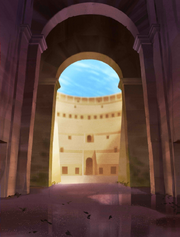
Entrance to the Coliseum
Whether it involves glitter or gore, the city’s arts district is known for drama. While a touch more bourgeois than the neighboring South End, the people of Goldgrave don’t shy away from making bold statements of dissent; the Community Theater’s Lucio-lampooning productions are always a hit. The Coliseum, once teeming with blood and bone, now secretly hosts the underground Red Market - your one-stop shop for contraband curios, many of which likely slipped into the city through the unscrupulous East Docks.
South End[]
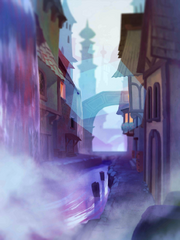
South End Market
Many might argue that South End, not the Heart District, is the true heart of Vesuvia. Whether you’re hiding out at Mazelinka’s house, drowning your sorrows at the Rowdy Raven, or meeting an old friend at the South End Market, you can trust South Enders not to snitch. Most of them, anyway. The residents of South End have generally been dealt a poor hand in life, but in every nook and cranny is someone determined to make the most of it in one way or another. The people of this neighborhood look out for each other, and they’re not afraid to speak their minds.
Temple District[]
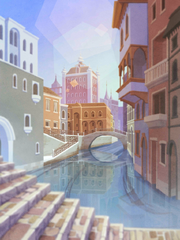
Canals in the Temple District
Great beauty and terrible poverty can be seen side-by-side in the Temple District. As a seaside port, in Vesuvia it is difficult to pin down specifically "Vesuvian" culture or beliefs; instead, the city is host to many cultures and beliefs brought there over the ages. The Temple District reflects this in its variety of stunning monuments, monasteries, shrines, and all manner of places of prayer to whatever one might pray to. Meanwhile, the wealth that poured into Vesuvia from Lucio’s conquests of neighboring city-states was never quite evenly distributed, and here the city’s poorest line the streets outside magnificent hallowed buildings, seeking alms from harried acolytes.
Flooded District[]
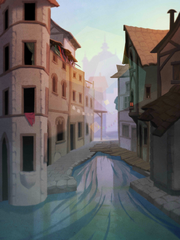
Canals in the Flooded District
This area was once known as the Shopping District, a hub for merchants hawking wares freshly brought in from the docks. Over the past several years, Vesuvia’s precarious sprawl on the edge of the sea - combined with a distinct lack of competent leadership - has caused conditions to drastically deterioriate, transforming this neighborhood into a much less desirable place for commerce. Without proper maintenance or preventative measures, the encroaching tides have overflowed canals and crumbled aging foundations, leaving sea-level streets to slowly sink and drown.
Ash Beach[]
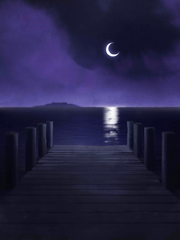
Docks at night
The beaches of Vesuvia have always been dark and drab. But during the years of the Plague, the smoke and waste from bodies burned on the Lazaret drifted to Ash Beach’s shores on steady winds and currents, and since then the deathly gray sands have truly lived up to their name. Ash Beach is home to orphans and sailors, the transient and dispossessed. People wash up here when they don’t belong anywhere else. As merchants began to abandon the Flooded District, the influx of trading vessels into Ash Beach slowed, and now strays and runaways far outnumber the ships at the Ash Docks.
The Lazaret[]
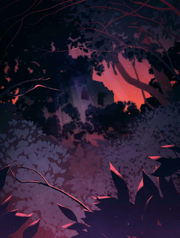
Ruins of Lazaret
What began as a place to quarantine victims of the Red Plague quickly became little more than a crematorium. Everyone knew the Lazaret was a death sentence; the island’s austere hospital was a coffin. Those who risked their lives to work there had little hope for finding a cure, and mostly sought to make plague victims’ last days as comfortable as possible - but even that became a daunting challenge as the dying rapidly outnumbered beds to comfortably die in. Now, with the plague gone, the island is abandoned. Its structures have been left to crumble, and ghost stories are whispered from the safety of the city’s shores.
Inspiration[]
The major source of inspiration for the setting was the Italian Renaissance. One of the biggest catalysts of the Renaissance was an influx of knowledge from outside of Europe. So rather than a strictly European-inspired setting, multitude of influences were included, just as Middle Eastern and North African cultures crossed the Mediterranean to impact southern Europe and beyond.
Trivia[]
- The use of structures such as aqueducts and coliseums along with certain characters having titles like Quaestor, Praetor, and so on hint towards Vesuvia having an infrastructure similar to the ancient Rome.
- Also the presence of the canals and gondolas, the Lazaret being a reference to the Poveglia island, and the roman infrastructure as well implies Vesuvia being similar to Italian city-states like Venice and Florence.

